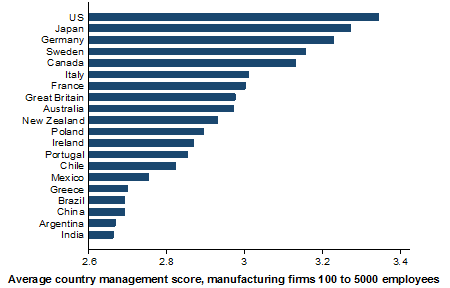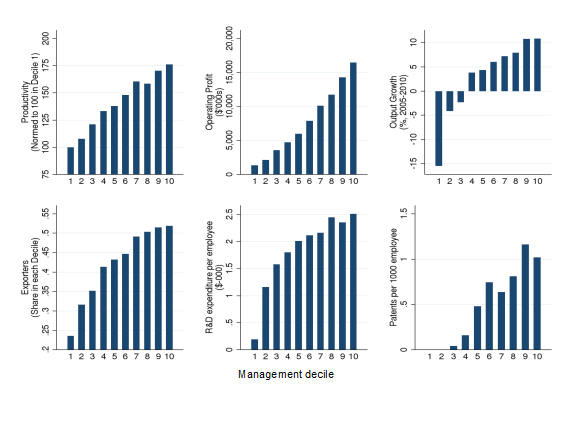In this article, Bloom and Patnaik bring together research that analyses management practices of firms, and how they relate to firm productivity and performance. They highlight the importance of undertaking a large-scale representative survey of management practices in India.
Tweet using #productivity
The productivity of firms in developing countries appears to be extremely low. Work by James Tybout (2000) and the World Bank (2003) highlights issues around infrastructure, informality, regulations, trade policies, and human capital that reduce the productivity of firms in developing countries. In addition, there has also been a long-held belief that poor management practices are an important driving force in holding back the productivity of developing country firms. Even among industrialised countries, management may affect productivity. For example, Toyota’s management system is credited with its productivity advantage over US auto firms, and the training of Italian managers under the Marshall plan had long-term effects on the performance of Italian firms in the post-World War II period (Giorcelli 2016). In developing countries, Bruhn, Karlan and Schoar (2013) have examined the role of consulting services in Mexico, while McKenzie and Woodruff (2013) have studied business practices in firms in Bangladesh, Chile, Ghana, Kenya, Mexico, Nigeria, and Sri Lanka, finding that management practices matter for firm performance and survival.
Management practices across countries
In the World Management Survey, Bloom and Van Reenen (2007) collected cross-country data on management practices in medium and large manufacturing firms from a wide range of developing and developed countries. These phone surveys score firms on monitoring practices (collection and processing of production information), target-setting practices (ability to set coherent, binding short- and long-run targets), and incentive practices (merit-based pay, promotion, hiring and firing). They find that firms in developing countries like Brazil, China, and India have significantly lower average management scores than firms in developed countries such as the US, Japan, and Western Europe (see Figure 1). The lower level of average management practices in developing countries is attributed to a persistent, thick tail of badly managed firms. The evidence surveyed in Bloom, Sadun and Van Reenen (2012) suggests a key factor behind this is low levels of competition and high levels of family ownership in developing countries, which leads to badly-run firms not exiting as they would in developed countries.
Figure 1. Management appears to be better in rich countries

Importance of management practices in large firms: Experimental evidence
Bloom et al. (2013) provide the first experimental evidence on the importance of management practices in large firms. They took large, multi-plant Indian textile firms and randomly allocated their plants to ‘treatment’ and ‘control’ groups. Treatment plants received five months of extensive management consulting from a large international consulting firm. This diagnosed opportunities for improvement in a set of 38 operational management practices during the first month, followed by four months of intensive support for the implementation of these recommendations. The control plants received only the one month of diagnostic consulting. The authors find that the treatment intervention led to significant improvements in quality, inventory, and output.
Within the first year, productivity had increased by 17%. Based on these changes, annual profitability was imputed to have increased by almost Rs. 20 million. These better managed firms also appeared to grow faster, with suggestive evidence that better management allowed them to delegate more and open more production plants in the three years following the start of the experiment. There were also network effects – these firms spread management improvements from their treatment plants to the other plants they owned, indicating revealed preference evidence on the beneficial impact of introducing these practices.
Given this large positive impact of modern management, the natural question is why firms had not previously adopted these practices. The evidence suggests that informational constraints were the most important factor. For many simple practices, firms that did not employ them didn't believe the practices would improve profitability. For example, on measuring quality and defects, the owners claimed their quality was as good as other local firms and thus they did not need to introduce a quality control process. For less common practices, like daily factory meetings, standardised operating procedures, or inventory control norms, firms were simply unaware of these practices. Although these types of lean management practices are common in Japan and the US, they appear to be rare in developing countries.
Competition has not forced such badly run firms to exit and has not allowed well-run firms to take over instead. The reason for the first is that competitive pressures were heavily restricted: imports by high tariffs, entry by the lack of external finance. On the growth of well-run firms, managerial time is constrained by the number of male family members. Non-family members are not trusted by firm owners with any decision-making power and as a result, these firms do not expand beyond the size that could be managed by close male family members. In fact, the number of male family members had more than three times the explanatory power for firm size than their management practices.
The authors revisit the plants eight years after the end of the original management intervention to study long-term impact of the introduction of structured management practices. Though they find that about half of the management practices adopted in the original experimental plants had been dropped, there remained a significant performance gap between treatment and control plants, suggesting lasting impacts of effective management interventions. Although few management practices had spread across firms, many had spread within firms from the experimental plants to the non-experimental plants, suggesting limited spillovers between firms but large spillovers within firms. Managerial turnover and the lack of director time were two of the most cited reasons for the drop in management practices in experimental plants, highlighting the importance of key employees for firm performance.
Management practices and firm performance: Large-scale, representative surveys
Outside of time-intensive firm surveys and experimental settings, another approach is wider paper-based surveys to capture management practices for a large number of representative firms or establishments. In a recent study, Bloom et al. (2017) worked with the US Census Bureau to design and conduct a wider survey of management practices in US manufacturing establishments. This allowed more coverage and representativeness in studying the use of structured management practices. The linking of the survey to establishment-level data allowed a comprehensive study of the relation between management and performance, and also helped identify drivers of the variation in management practices across establishments, and in particular across establishments within firms.
The authors found that while only one-fifth of plants use three-quarters or more of the performance-oriented management techniques that the survey covers, these plants had dramatically better performance than plants that adopted less structured practices. To start, Figure 2 provides a non-parametric view into management practices and six performance metrics. The figure shows a positive and broadly monotonic relationship between structured management and productivity, profitability, growth, exporting, research and development (R&D), and patenting.
Figure 2. Performance and management

The lack of consistent management practices across plants in the US is widespread. While 18% of plants had adopted three-quarters or more of basic structured management practices for things like performance monitoring, targets, and incentives, 27% had adopted less than half of such practices. Almost half of this variation in management practices occurs across plants within the same company. That means that in companies with multiple plants, there is considerable variation in practices across units. In addition, bigger companies don’t have it easier. In fact, management differences increased along with the size of the company, and larger businesses have substantially more discrepancies in management practices because they find it harder to fully align practices across their plants.
To help understand why structured management is so important and why there are wide differences among plants, the authors identified four causal ‘drivers’ that seem to influence corporate style and substance: product and market competition, state business environments, learning spillovers, and education.
- Product and market competition: Tougher competition is significantly correlated with more structured management practices. Competition prompts more diligent management practices among poorly managed companies, which will be forced to exit the market if they don’t adapt.
- State business environments: “Right-to-work” rules in the US often serve as a proxy for a state’s business environment, including reduced influence of labour unions and more flexible environmental and safety regulations. Right-to-work regulations make it easier for companies to link hiring, firing, pay, and promotion to employees’ ability and performance. In this study, the presence of right-to-work rules seemed to increase structured management practices around firing and promotions but seemed to have little impact on other practices.
- Learning spillovers: The study provides strong evidence that the arrival of large multinational plants will impact the management, employment, and productivity of pre-existing manufacturing plants in the area. This highlights the importance of localised, within-industry learning spillovers – there were no such spillover from large plant openings in retail or services.
- Human capital and educational resources: There are also significant effects on management practices and human capital as a result of educational opportunities and proximity to land-grant colleges, historically set up by the government. This was true despite a range of controls for other local variations in population density, income, and other county - and company-level factors. An increased supply of college graduates seems to lead to more structured management practices, even after controlling for local economic development.
These drivers account for about a third of the total variation in management practices. These drivers are likely important in other countries and contexts as well, especially developing countries where worker skills and education remain low and unionisation remains high.
A large-scale representative survey of management practices in India is important to study these topics in the context of India and allow comparison to the other countries. Management practices surveys in coordination with government have been conducted in several countries over the world, including Mexico, Pakistan, China, Japan, and Finland. Understanding the drivers of management practices in India can help boost productivity and firm performance in fundamental ways.
Notes
- Non-parametric statistics refer to a statistical method in which the data is not required to fit a normal distribution. A normal distribution, sometimes called the bell curve, is a distribution that occurs naturally in many situations. The bell curve is symmetrical – half of the data will fall to the left of the mean; half will fall to the right.
- A monotonic relationship is a relationship between two variables that does one of the following: (1) as the value of one variable increases, so does the value of the other variable; or (2) as the value of one variable increases, the other variable value decreases.
Further Reading
- Bloom, N, E Brynjolfsson, L Foster, RS Jarmin, M Patnaik, I Saporta-Eksten and J Van Reenen (2017), ‘What Drives Differences in Management?’, National Bureau of Economic Research Working Paper No. 23300.
- Bloom, Nicholas, Benn Eifert, Aprajit Mahajan, David McKenzie and John Roberts (2013), “Does Management Matter? Evidence from India”, The Quarterly Journal of Economics, 128(1):1-51. Available here.
- Bloom, Nicholas and John Van Reenen (2010), “Why Do Management Practices Differ across Firms and Countries?”, Journal of Economic Perspectives, 24(1):203-24.
- Bloom, Nicholas, Raffaella Sadun and John Van Reenen (2012), “The Organization of Firms Across Countries”, The Quarterly Journal of Economics, 127(4):1663-1705. Available here.
- Bruhn, M, D Karlan and S Antoinette (2013), ‘The impact of consulting services on small and medium enterprises: evidence from a randomized trial in Mexico’, Policy Research working paper no. WPS 6508, World Bank.
- Giorcelli, M (2016), ‘’, job market paper, 8 September 2016.
- McKenzie, David and Christopher Woodruff (2013), “What Are We Learning from Business Training and Entrepreneurship Evaluations around the Developing World?”, The World Bank Research Observer, 29(1):48-82.
- Tybout, James R (2000), “Manufacturing Firms in Developing Countries: How Well Do They Do, and Why?”, Journal of Economic Literature, 38(1):11-44.
- World Bank (2003), ‘Doing business in 2004: Understanding regulation’, International Finance Corporation and Oxford University Press.




 15 March, 2018
15 March, 2018 




Comments will be held for moderation. Your contact information will not be made public.